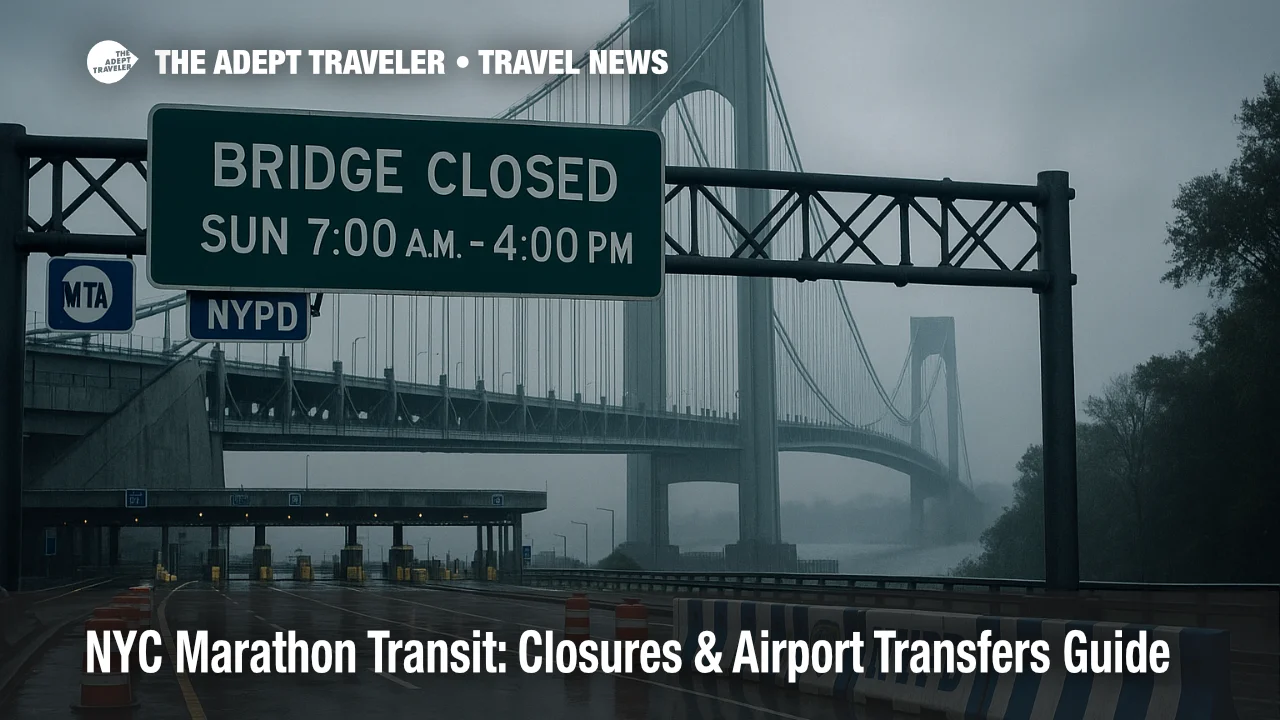NYC Marathon Transit: Closures & Airport Transfers Guide

Key points
- Verrazzano-Narrows Bridge closes to all non-emergency traffic 7:00 a.m.-4:00 p.m. ET on Sunday with the upper level closing 11:00 p.m. Saturday
- Expect rolling street closures and parking restrictions across all five boroughs along the course
- Use subway or LIRR to AirTrain for JFK, Q70 LaGuardia Link for LGA, and NJ Transit rail to AirTrain Newark for EWR
- Manhattan crosstown and north-south surface routes face delays and detours during peak race hours
- Leave 30-60 extra minutes for airport trips and avoid for-hire cars where the course intersects
Impact
- Plan Around Bridge Closure
- Avoid the Verrazzano-Narrows Bridge 7:00 a.m.-4:00 p.m. ET; use Goethals or Bayonne instead
- Choose Rail Over Roads
- Take subway or LIRR to AirTrain for JFK, Q70 LaGuardia Link for LGA, and NJ Transit rail to AirTrain Newark
- Buffer Your Airport Time
- Add 30-60 minutes for transfers and platform waits during peak race windows
- Check MTA Detours
- Expect bus diversions along the course including First Avenue and Fifth Avenue segments
- Mind Evening Reopenings
- Upper level prepares from 11:00 p.m. Saturday; full bridge reopens after about 4:00 p.m. Sunday
The TCS New York City Marathon runs Sunday, November 2, with rolling closures through Staten Island, Brooklyn, Queens, the Bronx, and Manhattan. The Verrazzano-Narrows Bridge closes to all non-emergency traffic from 700 a.m. to 400 p.m. ET, and its upper level closes in both directions beginning at 11:00 p.m. Saturday for set-up. That combination, plus course blocks in each borough, makes rail the fastest and most reliable way to reach the airports and to move around the city.
Course closures and the big bottleneck
City and broadcaster advisories flag extensive street closures on the route corridor, including key approaches to bridges and crosstown streets in Manhattan near Central Park, where finish operations compress traffic into the evening. Expect neighborhood-level no-parking rules to extend from Saturday into Sunday around staging and medical areas. The headline constraint is the Verrazzano-Narrows Bridge shutdown 700 a.m.-400 p.m., which cuts the direct Staten Island-Brooklyn link for private vehicles and for-hire cars. Drivers should use the Goethals or Bayonne bridges as alternates.
Airport transfer playbook
John F. Kennedy International Airport (JFK). From Manhattan or Brooklyn, take the subway or Long Island Rail Road to Jamaica, then transfer to AirTrain JFK. From southern Brooklyn or the Rockaways, the A Train to Howard Beach connects directly to AirTrain. These rail-first options bypass surface closures and typical race-day gridlock near bridges and crosstown choke points.
LaGuardia Airport (LGA). There is no AirTrain at LaGuardia. The fastest race-day option is the free Q70 SBS LaGuardia Link from Jackson Heights-Roosevelt Av/74 St, reached via the E, F, M, R, or 7 subway lines, or via LIRR to Woodside. Expect some Manhattan bus detours, so favor the Queens transfer to the Q70 over the M60 SBS on Fifth Avenue.
Newark Liberty International Airport (EWR). From New York Penn Station or Secaucus, ride NJ Transit to Newark Liberty International Airport Station, then transfer to AirTrain Newark. Travelers starting near the World Trade Center can take PATH to Newark Penn, then NJ Transit one stop to the airport station for AirTrain. Rail avoids Manhattan surface closures and the Queensboro Bridge crowding.
MTA service and bus detours
The MTA confirms marathon-day service planning, including the Verrazzano-Narrows Bridge closure timing and bus diversions along the course. Expect Manhattan north-south buses on First Avenue and Fifth Avenue, plus crosstown routes bordering Central Park, to face long delays or temporary turns. If you must use a bus, check live detours before you go, but whenever possible, substitute subway or commuter rail to a transfer point off the course.
How this works on the ground
Marathon operations move like a rolling work zone. Staten Island closures start early for the wave starts at Fort Wadsworth, then Brooklyn, Queens, and the Bronx activate by wave timing, with Manhattan's Upper East Side and Central Park South seeing the longest tail as runners finish. Even where streets reopen, heavy pedestrian volumes near the park and the finish will slow cabs and ride-shares. Rail lines under or away from the course maintain headways that are more predictable than surface roads on marathon day.
Practical timing and routing tips
Plan airport trips with a buffer of 30-60 minutes above your normal allowance. If you are on the East Side and headed to JFK, take the E to Jamaica for AirTrain or LIRR to Jamaica when available. For LGA, go to Jackson Heights for the Q70 SBS rather than trying to push a car through Midtown or along Fifth Avenue. For Newark, the simple rule is rail to AirTrain, not rideshare across Midtown or the Holland Tunnel corridor. These strategies align with current advisories from the MTA and Port Authority.
Final thoughts
A rail-first plan is the best way to sidestep Sunday's closures and finish-zone congestion. The Verrazzano-Narrows Bridge closure window and rolling course blocks make private cars and ride-shares unreliable. If your trip touches Manhattan during the race, default to subway or commuter rail, then connect to AirTrain JFK, Q70 LaGuardia Link, or NJ Transit plus AirTrain Newark.
Sources
- MTA press release: 2025 TCS NYC Marathon service and Verrazzano closure, times and detours
- NYC City Hall event notice, street closures and no-parking windows, November 1-2
- CBS New York closure recap, specific ramp restrictions and full-closure hours
- Port Authority weekly travel advisory encouraging mass transit for airport access
- MTA guide to JFK via subway or LIRR and AirTrain
- JFK Airport official: public transportation and AirTrain connections
- MTA guide to LaGuardia and the free Q70 LaGuardia Link
- MTA route page, Q70 LaGuardia Link details
- NJ Transit: Newark Liberty International Airport rail connection and AirTrain transfer
